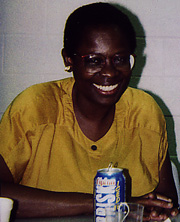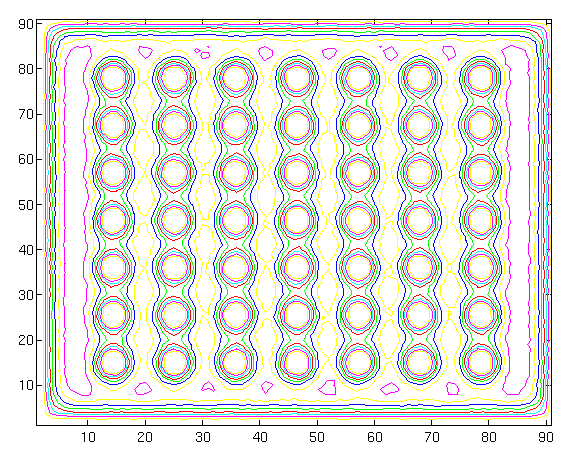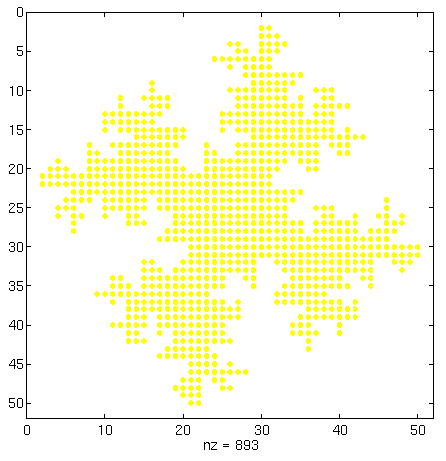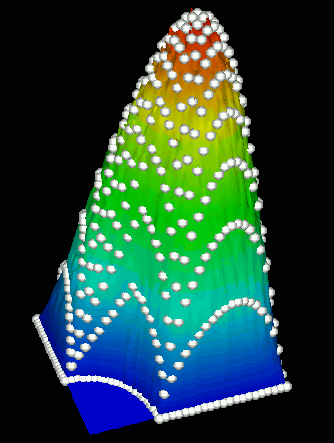Fern Hunt page 2 - her RESEARCH
back to Fern Hunt page 1
Fern Hunt's Research Publications
Modeling and Simulation of Weathering of Organic Coatings
Monte Carlo Calculation of Channel Fluid Flow
to the left Fern Hunt at the1997 CAARMS

BLACK WOMEN IN MATHEMATICS
|
Fern Hunt page 2 - her RESEARCH back to Fern Hunt page 1 Fern Hunt's Research Publications Modeling and Simulation of Weathering of Organic Coatings Monte Carlo Calculation of Channel Fluid Flow to the left Fern Hunt at the1997 CAARMS |
|
![]()
Modeling and Simulation of Weathering of Organic Coatings
The durability and attractiveness of paint or more generally organic coatings is crucial to the marketability and performance of manufactured products as disparate as automobiles,kitchen sinks and computer screens. Despite this, research on the scientific basis for appearance remains fragmented and in many cases dependent on the work performed decades ago by the National Bureau of Standards. The advent of environmental regulations and advances in material technology has stimulated the development of new coatings so a renewed effort in this area is a natural part of NIST's mission.
We undertook a study of the relation between the coating microstructure as formulated during the manufacturing process and the appearance of a painted surface after it has been damaged by UV radiation, as typically occurs during weathering due to outdoor exposure. We devised a computer simulation of the changes in microstructure that occur in a thin outer layer of a paint coating consisting of pigment particles and polymeric binder. The model shows the changes in morphology as the direction of Ultraviolet radiation and degree and mode of damage is varied. Variables that determine the coating microstructure during formulation such as pigment volume concentration, pigment size distribution and degree of pigment particle clustering or flocculation are parameters of the model. Random placement approximating a close packing distribution and the Neymann-Scott clustering process are used to generate coating microstructures and to parameterize the distribution of pigment particles. As a first approximation we chose to focus on gloss, the aspect of appearance that is at once of commercial importance and is a factor that is largely dependent on surface morphology through a surface roughness variable. This has been shown both experimentally and in theoretical work based on physical theories of light scattering (see Beckmann and Spizzichino, "The Scattering of Electromangnetic Waves From Rough Surfaces") . The dependence of surface roughness on pigment particle size distribution and degree of flocculation was investigated. Despite the obvious complexity of the weathering process we found similarities in the dependence of high gloss on the presence of many small well dispersed pigment particles as was seen in earlier studies of unweathered surfaces. The dependence of surface roughness on PVC however varied significantly with the degree of weathering. Below are figures from the simulation. Figure [gif] shows coating with a high degree of flocculation. This is very common in poorly mixed or "de- mixed" paints. All pigment distributions are so-called hard core random fields so there is no overlap.
| Graphic of simulation shows weathered surface with air shown above in gray and a thin layer of paint below. Spheres depict titanium dioxide pigment particles that are randomly placed in polymeric binder shown in white PVC=25. |
|
| Same PVC as above but minimum nearest neighbor distance is larger, decreasing the flocculation. Note surface roughness has decreased and thus surface will have glossier appearance. |
|
| Spheres depict titanium dioxide pigment particles that are randomly placed according to the Matern cluster process a simple type of Neymann-Scott point process. |
|
We proposed the construction of computer graphic images of surfaces depicting these relationships that could be used to visualize the trade-offs of various formulation strategies. These images could play a potentially important role in producing coatings with the most desirable gloss characteristics, given the constraints of cost and ease of manufacture. An interdisciplinary group consisting of Hunt, scientists from BFRL, Physics, and Manufacturing Engineering Laboratory was formed to develop and propose a research program at NIST in cooperation with industrial and academic colloborators. It would use advanced optical technology and metrology on the one hand and modelling and the use of computer graphic surface rendering on the other to identify and measure coating characteristics that produce surfaces with high quality appearance characteristics. The proposal recently won a NIST wide competition for competency funding for the next fiscal year and the group is in the process of planning the first stages of the project.
We proposed the construction of computer graphic images of surfaces depicting these relationships that could be used to visualize the trade-offs of various formulation strategies. These images could play a potentially important role in producing coatings with the most desirable gloss characteristics, given the constraints of cost and ease of manufacture. An interdisciplinary group consisting of Hunt, scientists from BFRL, Physics, and Manufacturing Engineering Laboratory was formed to develop and propose a research program at NIST in cooperation with industrial and academic colloborators. It would use advanced optical technology and metrology on the one hand and modelling and the use of computer graphic surface rendering on the other to identify and measure coating characteristics that produce surfaces with high quality appearance characteristics. The proposal recently won a NIST wide competition for competency funding for the next fiscal year and the group is in the process of planning the first stages of the project.
![]()
Monte Carlo Calculation of Channel Fluid Flow
Fern Y. Hunt
Jack Douglas, Polymers Division
The utilization of Monte Carlo methods for computing 2 and 3 dimensional viscous flow in channels of irregular cross-section is currently being investigated. Part of our research includes the development of an algorithm for channels with constant cross-section. The calculated fluid permeabilities and velocity values compare favorably for shapes where analytical or numerical (finite element method) results are available. The method is intended for use in obtaining approximate answers for geometries where finite element methods would be difficult to apply. Understanding the relationship between channel geometry and permeability is important in the control and design of injection mold and related manufacturing processes.
Figure 1 illustrates the velocity contour for a rectangular channel with cylindrical holes.

Figure 2 depicts the location of non-zero fluid velocity for a channel with fractal cross-section.

Figure 3 displays the velocity profile (height) of a simple cross-section. The Monte Carlo calculation is represented by the colored surface and the finite element solution is shown in white.

![]()
20. Hunt, F. Y.; Kearsley, A. J.; Wan, Honghui An optimization approach to multiple sequence alignment. Appl. Math. Lett. 16 (2003), no. 5, 785--790.
19. Hunt, Fern Y., Finite Precision Representation of the Conley Decomposition, Journal of Dynamical Systems and Differential Equations, 13(1), (2001), 87-105
18. Ding, Jiu; Hunt, Fern Y. Error estimates for quasi-compact Markov operators. Nonlinear Anal. 42 (2000), no. 1, Ser. A: Theory Methods, 85--95.
17. Hunt, Fern Y. Unique ergodicity and the approximation of attractors and their invariant measures using Ulam's method. Nonlinearity 11 (1998), no. 2, 307--317.
16. Galler, M. A.; Hunt, Fern Y.; Martin, J.W. Microstructure of Weathered Paint and its Relation to Gloss Loss, Computer Simulation and Modelling, Journal of Coatings Technology 70, No. 880, 45-54, 1998
15. Hunt, F. Y. Erratum: A Monte Carlo approach to the approximation of invariant measures , [Random Comput. Dynam. {2} (1994), no. 1, 111--133; MR 95a:58074]. Random Comput. Dynam. 5 (1997), no. 4, 361--362.
14. Hunt, Fern Approximating the invariant measures of randomly perturbed dissipative maps, J. Math. Anal. Appl. 198 (1996), 534--551.
13. Hunt, Fern Existence, Approximation and Convergence of Invariant Measures of Randomly Perturbed Maps , Proceedings of an International Conference on Differential Equations and Applications to Biology and to Industry Claremont, CA. 1995
12. Hunt, F. Y.; Douglas, J. F.; Bernal, J. Probabilistic computation of Poiseuille flow velocity fields. J. Math. Phys. 36 (1995), no. 5, 2386--2401.
11. Hunt, Fern A Monte Carlo approach to the approximation of invariant measures, Random Comput. Dynam. 2 (1994), 111--133.
10. Hunt, Fern ; McMichael, R. D. Analytical Expressions for Barkhausen Jump Size Distributions, IEEE Transactions on Magnetics, Vol. 30 (6), 4356-4358, 1994
9. Hunt, Fern Y.; Miller, Walter M. On the approximation of invariant measures , J. Statist. Phys. 66 (1992), 535--548.
8. Hunt, Fern Error analysis and convergence of capacity dimension algorithms . SIAM J. Appl. Math. 50 (1990), no. 1, 307--321.
7. Goldman, R.; Hunt, Fern Analysis of the Mechanism of O-Antigen Distribution and Lipopolysaccaride, J.Bact., Vol. 172, (9), 5352-5359, 1990
6. Hunt, Fern Y.; Sullivan, Francis Methods of computing fractal dimensions, Nonlinear semigroups, partial differential equations and attractors (Washington, DC, 1987), Lecture Notes in Math. 1394, Springer, Berlin-New York (1989) 83--95.
5. Hunt, Fern Y.; Sullivan, Francis Efficient Algorithms for Computing Fractal Dimensions, Conference on Dimensions and Entropies in Chaotic Systems, ed. G. Mayer-Kress 1986
4. Hunt, Fern A Mathematical Model of the Chitty Hypothesis, "Population Biology Proceedings, Edmonton, Canada", Lecture Notes in Biomathematics, Springer Verlag, N.Y. 1983,
3. Hunt, Fern Regulation of population cycles by genetic feedback: existence of periodic solutions of a mathematical model . J. Math. Biol. 13 (1981/82), no. 3, 271--282.
2. Hunt, Fern Genetic variation in patch populations . Math. Biosci. 52 (1980), no. 3-4, 207--215.
1. Hunt, Fern On the persistence of spatially homogeneous solutions of a population genetics model with slow selection, Math. Biosci.52 (1980), 185--206.
References: [Kenschaft, Black Women in Mathematics in the United States]; [Kenschaft, Black Men and Women in Mathematical Research] ; [ams careers] ; [nist-monte carlo] ; [nist 96]
SUMMA Fern Hunt web page: http://www.maa.org/summa/archive/hunt.html
back to Black Women in the Mathematical Sciences
![]()
The website
MATHEMATICIANS OF THE AFRICAN DIASPORA
are brought to you by
The Mathematics Department of
The State University of New York at Buffalo.
They are created and maintained
by
Scott W. Williams
Professor of Mathematics